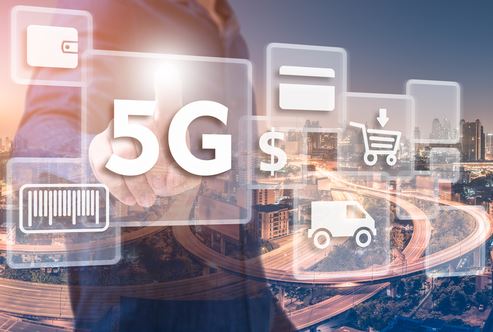As the Internet of Things continues to grow, the way we connect our wireless devices needs to run faster and better. 5G, the fifth generation of wireless technology, is expected to revolutionize the Internet of Things with its ability to transmit data about 10 times faster than 4G LTE, according to Ericsson's Annual Mobility Report.
5G may not exist quite yet, but it's already hyped up to be a huge innovation in technology. The 5th generation of wireless technology is expected to launch by 2020. The standard for 5G hasn't been set yet, but there are many speculations about what 5G will entail and how it will impact the Internet of Things.
The exact specifications of 5G are still unknown, but here's a little about what we know about the future of wireless technology:
5G and the Future of the Internet of Things
However, 5G is more than just faster speeds. The next generation of wireless technology will bring about a lower latency, which means that response times will be faster. Additionally, it will increase battery life and the number of simultaneous connections. 5G will also unlock all new applications, while today's applications run better and faster. For example, with a phone equipped for 5G, users will be able to play competitive mobile online games similar to the way they might on a computer.
The potential innovations for technology using 5G is endless. Smart phones will become faster and smarter and new types of wireless connected devices will emerge. From self-driving cars to earpieces that provide real-time natural language translations, the speculation for what 5G means for the future is endless.
5G is expected to transform the way that fixed and mobile devices communicate with each other, creating technology innovations that currently aren't feasible with 4G, such as the implementation of a smart city. In the future, global wireless markets will be flooded with smart devices that require high speed and high data volumes, something current networks will struggle to handle. Unlike previous generations of wireless technology, 5G will use a new radio access technology with multi-layered networks to handle high throughputs and an increased data value at a low latency.
Future wireless technology will be expected to be able to manage self-driving cars, distant healthcare and the development of smart cities, which means that serious infrastructure will need to be put into place before 5G can roll out. Similar to 4G, it's expected to originally launch in major metropolitan areas before it expands across the nation. However, it's expected to perform better in dense populations, which means that users living in major cities will be less likely to experience dropped calls or laggy networks. In rural communities, it could be the solution to using dial-up, satellite or spotty 4G connections.
Gearing up to 5G
It will be a while until 5G rolls out, but carriers are already gearing up for its release. T-Mobile, for example, became the first U.S. wireless company to announce its plans to deliver 5G coverage from coast to coast, using a portion of its low-band 600 MHz spectrum.
In the meantime, T-Mobile customers can enjoy a boost of speed and connectivity using Wi-Fi Calling while they wait for 5G to roll out nationwide. Wi-Fi Calling uses Wi-Fi connections like they are T-Mobile towers, providing unlimited talk and text whenever you're in range.



 United Airlines Tokyo-Bound Flight Returns to Dulles After Engine Failure
United Airlines Tokyo-Bound Flight Returns to Dulles After Engine Failure  Air Force One Delivery Delayed to 2028 as Boeing Faces Rising Costs
Air Force One Delivery Delayed to 2028 as Boeing Faces Rising Costs  Evercore Reaffirms Alphabet’s Search Dominance as AI Competition Intensifies
Evercore Reaffirms Alphabet’s Search Dominance as AI Competition Intensifies  HSBC’s $13.6 Billion Take-Private Offer for Hang Seng Bank Gains Board Backing
HSBC’s $13.6 Billion Take-Private Offer for Hang Seng Bank Gains Board Backing  Fortescue Expands Copper Portfolio With Full Takeover of Alta Copper
Fortescue Expands Copper Portfolio With Full Takeover of Alta Copper  Nomura Expands Alternative Assets Strategy With Focus on Private Debt Acquisitions
Nomura Expands Alternative Assets Strategy With Focus on Private Debt Acquisitions  JD.com Pledges 22 Billion Yuan Housing Support for Couriers as China’s Instant Retail Competition Heats Up
JD.com Pledges 22 Billion Yuan Housing Support for Couriers as China’s Instant Retail Competition Heats Up  Azul Airlines Wins Court Approval for $2 Billion Debt Restructuring and New Capital Raise
Azul Airlines Wins Court Approval for $2 Billion Debt Restructuring and New Capital Raise  Moore Threads Stock Slides After Risk Warning Despite 600% Surge Since IPO
Moore Threads Stock Slides After Risk Warning Despite 600% Surge Since IPO  Apple App Store Injunction Largely Upheld as Appeals Court Rules on Epic Games Case
Apple App Store Injunction Largely Upheld as Appeals Court Rules on Epic Games Case  SK Hynix Considers U.S. ADR Listing to Boost Shareholder Value Amid Rising AI Chip Demand
SK Hynix Considers U.S. ADR Listing to Boost Shareholder Value Amid Rising AI Chip Demand  Trello Outage Disrupts Users as Access Issues Hit Atlassian’s Work Management Platform
Trello Outage Disrupts Users as Access Issues Hit Atlassian’s Work Management Platform  United Airlines Flight to Tokyo Returns to Dulles After Engine Failure During Takeoff
United Airlines Flight to Tokyo Returns to Dulles After Engine Failure During Takeoff  SoftBank Shares Slide as Oracle’s AI Spending Plans Fuel Market Jitters
SoftBank Shares Slide as Oracle’s AI Spending Plans Fuel Market Jitters  ANZ Faces Legal Battle as Former CEO Shayne Elliott Sues Over A$13.5 Million Bonus Dispute
ANZ Faces Legal Battle as Former CEO Shayne Elliott Sues Over A$13.5 Million Bonus Dispute  Korea Zinc Plans $6.78 Billion U.S. Smelter Investment With Government Partnership
Korea Zinc Plans $6.78 Billion U.S. Smelter Investment With Government Partnership  Mizuho Raises Broadcom Price Target to $450 on Surging AI Chip Demand
Mizuho Raises Broadcom Price Target to $450 on Surging AI Chip Demand 































